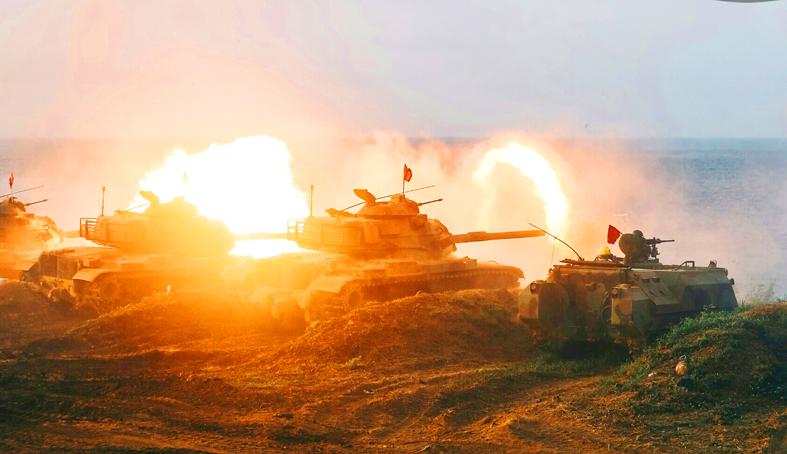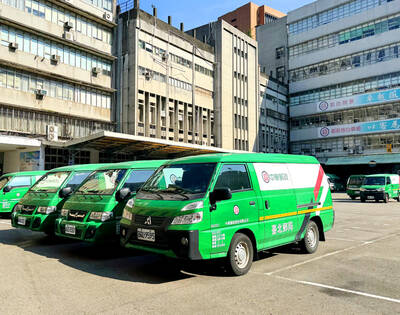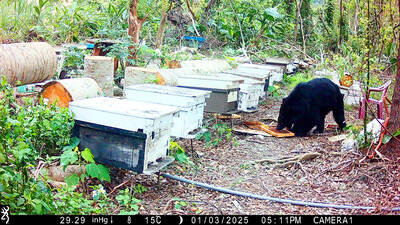A full Chinese invasion of Taiwan with troops landed and ports and airports seized would be very difficult to achieve due to problems China would have in landing and supplying troops, the Ministry of National Defense said in its latest threat assessment.
In a report to lawmakers, the ministry said as China’s transport capacity is limited, it would not be able to land all its forces in one go, and would have to rely on “non-standard” roll-on, roll-off ships that would need to use port facilities and transport aircraft that would need airports.
“However, the nation’s military strongly defends ports and airports, and they will not be easy to occupy in a short time. Landing operations will face extremely high risks,” the ministry said in its report, a copy of which was reviewed by Reuters.

Photo courtesy of the Military News Agency via CNA
China’s logistics face challenges, too, as any landing forces would need to be resupplied with weapons, food and medicine across the Taiwan Strait, it added.
“The nation’s military has the advantage of the Taiwan Strait being a natural moat and can use joint intercept operations, cutting off the communist military’s supplies, severely reducing the combat effectiveness and endurance of the landing forces,” the report said.
China would also need to keep some of its forces in reserve to prevent any foreign forces joining in to help Taiwan and to keep a close watch on other fractious areas of China’s border, such as with India and in the South China Sea, the report said.
“US and Japanese military bases are close to Taiwan, and any Chinese Communist attack would necessarily be closely monitored, plus it would need to reserve forces to prevent foreign military intervention,” it said. “It is difficult to concentrate all its efforts on fighting with Taiwan.”
Experts say that China has other means at its disposal to bring Taiwan to its knees short of a full invasion, including a blockade or targeted missile attacks.
President Tsai Ing-wen (蔡英文) is overseeing a military modernization program to make Taiwan harder to attack, making the military more mobile and providing it with precision weapons such as long-range missiles to take out an attacking force.
The government is planning to spend an extra NT$240 billion (US$8.63 billion) over the next five years mostly on weapons and new warships for the navy.

SHIPS, TRAINS AND AUTOMOBILES: The ministry has announced changes to varied transportation industries taking effect soon, with a number of effects for passengers Beginning next month, the post office is canceling signature upon delivery and written inquiry services for international registered small packets in accordance with the new policy of the Universal Postal Union, the Ministry of Transportation and Communications said yesterday. The new policy does not apply to packets that are to be delivered to China, the ministry said. Senders of international registered small packets would receive a NT$10 rebate on postage if the packets are sent from Jan. 1 to March 31, it added. The ministry said that three other policies are also scheduled to take effect next month. International cruise ship operators

NUMBERS IMBALANCE: More than 4 million Taiwanese have visited China this year, while only about half a million Chinese have visited here Beijing has yet to respond to Taiwan’s requests for negotiation over matters related to the recovery of cross-strait tourism, the Tourism Administration said yesterday. Taiwan’s tourism authority issued the statement after Chinese-language daily the China Times reported yesterday that the government’s policy of banning group tours to China does not stop Taiwanese from visiting the country. As of October, more than 4.2 million had traveled to China this year, exceeding last year. Beijing estimated the number of Taiwanese tourists in China could reach 4.5 million this year. By contrast, only 500,000 Chinese tourists are expected in Taiwan, the report said. The report

The Forestry and Nature Conservation Agency yesterday launched a gift box to market honey “certified by a Formosan black bear” in appreciation of a beekeeper’s amicable interaction with a honey-thieving bear. Beekeeper Chih Ming-chen (池明鎮) in January inspected his bee farm in Hualien County’s Jhuosi Township (卓溪) and found that more than 20 beehives had been destroyed and many hives were eaten, with bear droppings and paw prints near the destroyed hives, the agency said. Chih returned to the farm to move the remaining beehives away that evening when he encountered a Formosan black bear only 20m away, the agency said. The bear

Chinese embassy staffers attempted to interrupt an award ceremony of an international tea competition in France when the organizer introduced Taiwan and displayed the Republic of China flag, a Taiwanese tea farmer said in an interview published today. Hsieh Chung-lin (謝忠霖), chief executive of Juxin Tea Factory from Taichung's Lishan (梨山) area, on Dec. 2 attended the Teas of the World International Contest held at the Peruvian embassy in Paris. Hsieh was awarded a special prize for his Huagang Snow Source Tea by the nonprofit Agency for the Valorization of Agricultural Products (AVPA). During the ceremony, two Chinese embassy staffers in attendance